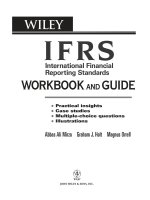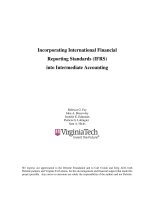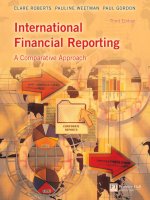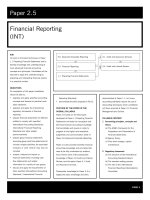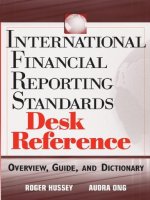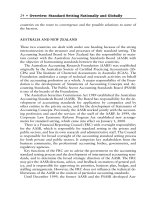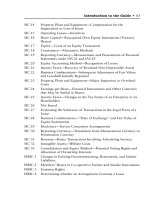International Financial Reporting pdf
Bạn đang xem bản rút gọn của tài liệu. Xem và tải ngay bản đầy đủ của tài liệu tại đây (6.72 MB, 731 trang )
International Financial Reporting
A Comparative Approach
ROBERTS
WEETMAN
GORDON
Third Edition
An imprint of
www.pearson-books.com
Clare Roberts BSc MSc PhD is Professor of Accounting at the University of
Aberdeen. She has held permanent teaching positions in the UK at Glasgow and
Exeter Universities, and visiting positions in the US at Texas A & M University and
the University of California Santa Barbara, and in Australia at Newcastle University,
New South Wales.
Pauline Weetman BA (Oxon) BSc PhD CA is Professor of Accounting at the
University of Strathclyde and was formerly Dean of Faculty and Professor of
Accounting at Heriot-Watt University. She received the British Accounting
Association’s Distinguished Academic Award in 2005.
Paul Gordon BA MA FCA is Lecturer in Accounting and Finance at Heriot-Watt
University, having held positions at Glasgow, Aberdeen and Wales (Bangor).
International Financial Reporting: A
Comparative Approach is ideal for advanced
undergraduate and postgraduate students of
accounting and international business,
studying in any country throughout the
world.
Fully updated to reflect the ongoing changes in international accounting standards, International Financial
Reporting contrasts the processes of convergence on global harmonisation with the continuing causes of
national diversity in accounting and accountability. It analyses the work of the International Accounting
Standards Board in setting internationally applied standards (IFRS) of measurement and disclosure.
New to this edition
• Increased focus on accountability in
corporate reporting, particularly the
impact of the Sarbanes-Oxley Act.
• Focus on the whole annual report
including narrative reporting.
• The development of financial
reporting practices across Europe is
integrated in one chapter with
particular reference to Poland as the
largest economy entering the EU in
the 2004 enlargement.
Key Features
• Chapters on research in international
accounting, commended by users of previous
editions.
• Coverage of use of accounting information by
global market participants.
• Includes examples of accounting practices
drawn from the published accounts and
reports of multinational companies such as
Heineken, Kingfisher, Kodak and Wal-Mart.
• A chapter on ‘issues in multinational
accounting’ provides a comparative discussion
of national practices in relation to IFRS.
International Financial Reporting
IFR_A01.QXD 20/11/2005 05:42 PM Page i
We work with leading authors to develop the strongest
educational materials in accountancy, bringing
cutting-edge thinking and best learning practice to a
global market.
Under a range of well-known imprints, including
Financial Times Prentice Hall, we craft high quality print
and electronic publications which help readers to
understand and apply their content, whether studying
or at work.
To find out more about the complete range of our
publishing, please visit us on the World Wide Web at:
www.pearsoned.co.uk
IFR_A01.QXD 20/11/2005 05:42 PM Page ii
International Financial Reporting
A Comparative Approach
CLARE ROBERTS
PAULINE WEETMAN
PAUL GORDON
Third Edition
IFR_A01.QXD 20/11/2005 05:42 PM Page iii
Pearson Education Limited
Edinburgh Gate
Harlow
Essex CM20 2JE
England
and Associated Companies throughout the world
Visit us on the World Wide Web at:
www.pearsoned.co.uk
First published in Great Britain by Financial Times Professional Limited 1998
Second edition 2002
Third edition 2005
© Pearson Professional Limited 1998
© Pearson Education 2002, 2005
The rights of Clare Roberts, Pauline Weetman and Paul Gordon to be
identified as authors of this work have been asserted by them in accordance
with the Copyright, Designs and Patents Act 1988.
All rights reserved. No part of this publication may be reproduced, stored in
a retrieval system, or transmitted in any form or by any means, electronic,
mechanical, photocopying, recording, or otherwise, without either the prior
written permission of the Publishers or a licence permitting restricted copying
in the United Kingdom issued by the Copyright Licensing Agency Ltd,
90 Tottenham Court Road, London W1T 4LP.
ISBN-10: 0-273-68118-4
ISBN-13: 978-0-273-68118-2
British Library Cataloguing-in-Publication Data
A catalogue record for this book is available from the British Library.
Library of Congress Cataloging-in-Publication Data
10 98765432
09 08 07 06 05
Typeset by 68 in 9/12 Stone.
Printed by Ashford Colour Press Ltd., Gosport.
The publisher’s policy is to use paper manufactured from sustainable forests.
IFR_A01.QXD 20/11/2005 05:42 PM Page iv
v
Preface xii
Acknowledgements xvii
Publisher’s acknowledgements xix
Plan of the book xxi
Part 1 SETTING AND REGULATING INTERNATIONAL FINANCIAL
REPORTING STANDARDS
Introduction to Part 1 3
1 Developing global accounting standards
5
Learning outcomes 6
1.1 Introduction 6
1.2 Global accounting standards: support and opposition 6
1.3 Organizations supporting international cooperation 11
1.4 The IASCF and the IASB 16
1.5 Operation of the IASB 19
1.6 The IASB standards 21
1.7 Changing styles of setting international standards 25
1.8 IASB framework 32
1.9 Multinational companies 37
Summary and conclusions 45
Questions 46
References and further reading 47
2 International financial reporting standards
50
Learning outcomes 51
2.1 Introduction 51
2.2 Disclosure and presentation 52
2.3 Asset recognition and measurement 63
2.4 Liability recognition and measurement 70
2.5 Financial instruments: assets and liabilities 75
2.6 Recognition of economic activity 79
2.7 Measurement of inflation 83
2.8 Group accounting 84
2.9 Specialist organizations and industries 90
Contents
IFR_A01.QXD 20/11/2005 05:42 PM Page v
Contents
vi
Summary and conclusions 91
Questions 92
References and further reading 93
3
Confidence and assurance
94
Learning outcomes 95
3.1 Introduction 95
3.2 Improving the credibility of financial reporting 96
3.3 Auditing and assurance 102
3.4 Corporate governance and financial reporting 108
3.5 Corporate Social Responsibility 115
3.6 Regulating compliance 120
3.7 A research perspective 124
Summary and conclusions 127
Case study 3.1 Corporate governance: Germany 128
Case study 3.2 Corporate governance: Japan 129
Case study 3.3 Corporate governance: UK 131
Case study 3.4 Corporate governance: US 132
Case study 3.5 Corporate governance: Kenya 133
Case study 3.6 Corporate governance: Poland 134
Questions 135
References and further reading 136
Part 2 CONTRASTING HARMONIZATION AND DIVERSITY
ACROSS FINANCIAL REPORTING SYSTEMS
Introduction to Part 2 141
4
Institutional and external influences on accounting
rules and practices
143
Learning outcomes 144
4.1 Introduction 144
4.2 Factors influencing the development of accounting systems 145
4.3 The political and economic system 146
4.4 The legal system 150
4.5 The taxation system 152
4.6 The corporate financing system 154
4.7 The accounting profession 159
4.8 Other influences 161
Summary and conclusions 164
Case study 4.1 Accounting in Turkey: external influences 164
Case study 4.2 Accounting in ASEAN: external influences 165
Questions 166
References and further reading 168
IFR_A01.QXD 20/11/2005 05:42 PM Page vi
Contents
vii
5
Cultural influences on accounting rules and practices
170
Learning outcomes 170
5.1 Introduction 171
5.2 Defining culture 171
5.3 Culture and business 180
5.4 Culture and accounting 183
5.5 Is culture an important influence on accounting? 187
Summary and conclusions 189
Case study 5.1 Accounting for related parties in the UK and Tanzania 190
Questions 193
References and further reading 194
6
The classification of accounting systems
196
Learning outcomes 196
6.1 Introduction 197
6.2 Reasons for classifying accounting systems 198
6.3 Types of classification schemes 198
6.4 Inductive classifications of accounting systems 203
6.5 Deductive classifications of accounting systems 210
6.6 What conclusions can be drawn? 220
Summary and conclusions 221
Questions 222
References and further reading 223
7
Measuring harmonization and diversity
225
Learning outcomes 226
7.1 Introduction 226
7.2 Sources of differences between accounting systems 226
7.3 The importance of increasing harmonization in accounting
systems 229
7.4 Similarities and differences in reported figures 231
7.5 Similarities and differences in the accounting methods used 238
7.6 Similarities and differences in information disclosure 247
7.7 Good news, bad news and earnings ‘conservatism’ 255
Summary and conclusions 260
Case study 7.1 Daimler–Benz: Reconciliation of earnings from German
to US GAAP 260
Case study 7.2 A simulation study of UK and French accounting 261
Questions 263
References and further reading 264
Appendix 7.1 A further explanation of how to calculate the C-index 268
Appendix 7.2 Empirical studies on voluntary disclosure 270
IFR_A01.QXD 20/11/2005 05:42 PM Page vii
Contents
viii
Part 3 SIGNIFICANT INFLUENCES ON INTERNATIONAL
ACCOUNTING PRACTICES
Introduction to Part 3 285
8
The United States of America
287
Learning outcomes 288
8.1 Introduction 288
8.2 The country 288
8.3 Development of accounting regulation 290
8.4 Institutions 294
8.5 External influences 304
8.6 Comparison with IFRS 304
8.7 The accounting system 308
8.8 Gray’s accounting values 342
Summary and conclusions 344
Questions 345
References and further reading 346
9
The European Union
349
Learning outcomes 350
9.1 Introduction 350
9.2 Origins and nature of the EU 350
9.3 How laws are made 353
9.4 Impact of IASB Standards on accounting in the EU 353
9.5 The IAS Regulation 355
9.6 Company law directives 358
9.7 The Fourth Directive 362
9.8 The Seventh Directive 367
9.9 Modernization of the Directives 369
9.10 Recommendation on environmental issues 370
Summary and conclusions 371
Questions 371
References and further reading 372
Appendix 9.1 Formats in the Fourth Directive 374
Part 4 FROM NATIONAL TO INTERNATIONAL STANDARDS
Introduction to Part 4
381
10
Accounting in EU member states
385
Learning outcomes 386
10.1 Introduction 386
IFR_A01.QXD 20/11/2005 05:42 PM Page viii
Contents
ix
10.2 The countries 387
10.3 International standards; national choices 389
10.4 Institutional influences 396
10.5 External influences 415
10.6 Oversight and assurance 417
10.7 Accounting issues 424
10.8 Comparative research studies 434
Summary and conclusions 436
Questions 437
References and further reading 438
11
The United Kingdom
441
Learning outcomes 442
11.1 Introduction 442
11.2 The country 442
11.3 Development of accounting regulation 444
11.4 Institutions 447
11.5 External influences 458
11.6 Oversight and assurance 460
11.7 Accounting issues 465
11.8 Gray’s accounting values 473
Summary and conclusions 475
Questions 476
References and further reading 477
12
Japan
480
Learning outcomes 480
12.1 Introduction 481
12.2 The country 482
12.3 Development of accounting regulations 484
12.4 Institutions 495
12.5 External influences 501
12.6 Accounting regulations and the IASB 502
12.7 Information disclosure 508
Summary and conclusions 510
Questions 511
References and further reading 512
13
China
514
Learning outcomes 515
13.1 Introduction 515
13.2 The country 516
13.3 Development of accounting regulation 517
13.4 Institutions 523
IFR_A01.QXD 20/11/2005 05:42 PM Page ix
Contents
x
13.5 External influences 534
13.6 Accounting regulations and the IASB 535
13.7 The accounting system 541
13.8 Hong Kong China 547
13.9 Gray’s accounting values 553
13.10 Empirical studies 554
Summary and conclusions 556
Questions 557
References and further reading 559
Appendix 13.1 Accounting System for Business Enterprises 561
Appendix 13.2 Differences between Hong Kong GAAP and US
GAAP: CNOOC Ltd 564
Part 5 INFORMING INTERNATIONAL EQUITY MARKETS
Introduction to Part 5 573
14
Investors and listed companies
575
Learning outcomes 576
14.1 Introduction 576
14.2 Approaches to international equity investment 576
14.3 Future demand for and supply of international equity investments 582
14.4 Benefits of foreign stock market listing 585
14.5 Listing behaviour of companies 589
14.6 Empirical research into stock market listing choices 597
14.7 Other users of financial statements 599
14.8 Methods of reporting to foreign users 600
Summary and conclusions 605
Questions 606
References and further reading 607
15
Transparency and disclosure
611
Learning outcomes 611
15.1 Introduction 612
15.2 The meaning of ‘transparency’ 612
15.3 Narrative reporting in the US 615
15.4 Management reports in other countries 623
15.5 Corporate social responsibility (CSR) reports 629
15.6 Remuneration reports 634
15.7 Comparative research into disclosure 637
Summary and conclusions 642
Questions 643
References and further reading 644
IFR_A01.QXD 20/11/2005 05:42 PM Page x
Contents
xi
16
Issues in multinational accounting
647
Learning outcomes 648
16.1 Introduction 648
16.2 Defining a group 649
16.3 Acquisition and uniting of interests 657
16.4 Goodwill 665
16.5 Associates and joint ventures 667
16.6 Segment reporting 670
16.7 Foreign currency translation 681
Summary and conclusions 691
Questions 692
References and further reading 693
Index 695
Supporting resources
Visit www.pearsoned.co.uk/roberts to find valuable online resources
For instructors
● Complete, downloadable Learning Resources
● PowerPoint slides that can be downloaded and used as OHTs
For more information please contact your local Pearson Education sales representative
or visit www.pearsoned.co.uk/roberts
IFR_A01.QXD 20/11/2005 05:42 PM Page xi
xii
Introduction
This third edition takes as its theme ‘increasing harmonization in financial statements;
mixed comparability and diversity in assurance and corporate reporting’.
January 2005 marked a significant stage in the move towards acceptance of interna-
tional financial reporting standards (IFRS) as the basis for harmonizing financial state-
ments. It was the date from which listed companies in member states of the European
Union (EU) were required to apply IFRS in their consolidated financial statements, in
place of the accounting standards of their home countries. Beyond Europe other coun-
tries have taken a range of attitudes. Some have adopted the IFRS in full; some have
revised their national standards to incorporate the main aspects of IFRS with some local
variation; others are still considering their options.
The third edition of this book reflects the contrasting forces of the focus on global
harmonization, on the one hand, and the desire to retain some element of national
identity control, on the other hand. The national identity remains most apparent in the
regulation of assurance of the quality of financial statements and in the wider narrative
reporting that accompanies the financial statements.
In an ideal world there would be no further scope for a comparative study of inter-
national financial reporting because harmonization would be complete. In reality, dif-
ferences persist. Although the International Organization of Securities Commissions
(IOSCO) endorsed IFRS in 2000, it left an option for individual securities commissions
to scrutinize the IFRS and add further conditions to them. The IASB has faced the chal-
lenge of establishing confidence in its independence as a standard setter, while having
no direct powers of enforcement or scrutiny. In the period from 2000 to 2005 we
observed the legislators of two major economic groupings (the EU and the US) using the
language of ‘convergence’ while preserving territorial positions. The European
Commission retained its right of political control over the legal process across member
states. The Securities and Exchange Commission of the United States awaited reassur-
ance about mechanisms for enforcement of high-quality international accounting
standards that would retain a level playing field for US companies.
The challenge to accounting standards took a new direction following the collapse of
a major US company, Enron, which showed that even the US accounting standards were
not immune from criticism. It seemed that the mechanisms of corporate governance
and regulatory oversight were inadequate to protect stakeholders. Further corporate
scandals indicated that problems of this kind could exist in large listed companies in
countries beyond the US.
Corporate failures caused a major loss of confidence for investors in global markets.
To restore confidence, the processes of corporate governance and assurance (including
audit) have been revised significantly in many countries, although regulation remains
primarily under national laws. We are now aware that the implementation of any system
Preface
IFR_A01.QXD 20/11/2005 05:42 PM Page xii
Preface
xiii
of financial reporting is critically dependent on the quality of the corporate governance
and assurance mechanisms of the national regulator.
As a separate aspect of accountability for social and environmental matters, there has
been increasing emphasis on corporate social reporting (CSR) to the point where high-
quality CSR information is seen as essential by those evaluating investment possibilities.
Information about responsibilities to employees, customers, communities and society in
general is now a common feature of many annual reports. It is part of the wider focus
on narrative reporting to explain the activities of the business.
In this third edition we aim to provide insight into the areas of comparability, and
the persistence of diversity, in the corporate annual reports of listed companies across
global markets. We also indicate how national diversity may continue to be significant
for non-listed companies and for reporting in a national context. All the developments
we have described in this introduction are fascinating to researchers and we have built
into the third edition a wide range of examples of research studies in this area that will
be of interest to students and may offer ideas for their own future research projects.
Aim of the book
This text aims to bring to undergraduate and postgraduate courses in accounting and
finance an awareness of similarities and differences in accounting practices and an abil-
ity to analyze the causes and consequences of those similarities and differences. There is
a strong emphasis placed on IASB Standards as the focus of comparison.
The book aims also to familiarize students with the growing body of research into
international accounting practices, giving detailed explanation of research methods that
may encourage students to apply such techniques in project work.
Structure of the book
The book is divided into five modules (Parts 1 to 5) each of which deals with a sepa-
rate aspect of international corporate reporting. The full text is suitable for a full
15-week semester but the modular structure allows lecturers to plan selectively for
shorter courses.
The third edition starts in Part 1 by describing in Chapter 1 the achievements of the
IASB in establishing its position as an international standard setter and explaining in
Chapter 2 how the IFRS have developed to be more rigorous in application. Chapter 3,
entirely new to this edition, provides a new feature by exploring the complex framework
of assurance mechanisms that have been established to give credibility to international
and national reporting practices. It reflects the actions taken by a wide range of institu-
tions, both statutory and voluntary, to restore confidence in financial reporting after the
Asian economic crisis and the collapse of Enron in the US.
Part 2 presents the well-regarded analytical focus of the book by setting the analytical
framework for the study of accounting practice and explaining the methods used in var-
ious types of comparative reporting study. The institutional framework is described in
Chapter 4, covering in general terms the influence of the political system, the economic
system, the legal system, the tax system, the financing system and the accounting pro-
fession. Cultural influences on accounting rules and practice are critically evaluated in
Chapter 5 using well-known academic sources. Classification of accounting systems, as
presented in Chapter 6, provides a framework indicating international similarities and
IFR_A01.QXD 20/11/2005 05:42 PM Page xiii
Preface
xiv
differences. Practical approaches to measuring international differences in accounting
rules and practices are presented in Chapter 7, drawing on methods established in the
research literature that are suitable for student project applications.
Part 3 describes two powerful forces that are shaping the development of interna-
tional standards: the US with its system of US GAAP and the EU with 25 member states
committed to the application of IFRS from 2005. The accounting system in the US is a
rival to the IFRS as a potential global accounting system. The approach taken by the EU
in undertaking to require all listed companies to use IFRS from 2005 has given a major
endorsement to IFRS.
Part 4 describes how a selection of countries have moved towards adoption of IFRS.
We have included in our selection two countries with strongly established capital mar-
kets (UK and Japan), three countries with established capital markets in Europe (France,
Germany and The Netherlands) and two countries that are still at relatively early stages
of development of capital markets (Poland and China). In these country chapters we
relate accounting developments to the institutional environment within which account-
ing practice operates. We recognize that whatever selection we make does not please
everyone; to meet this concern there is further information on other countries in the
Lecturer’s Guide provided to accompany this edition.
Part 5 takes us to the international capital markets with a discussion in Chapter 14 of
the motivations and strategies of investors and listed companies who operate across
national boundaries in investing and in issuing shares. Chapter 15 is new to this edition
and reflects the growing importance of narrative reporting in achieving transparency in
financial reporting. The chapter explains and illustrates the range of approaches taken
by companies to improve transparency through disclosure. Chapter 16 is also new to
this edition and explains the significant achievements of IFRS in bringing harmoniza-
tion to accounting regulation and practice in three areas: business combinations;
segmental reporting; and foreign currency translation.
Particular features
We have retained from previous editions the features that students and lecturers have
identified as particularly helpful:
● there is a strong emphasis on IASB Standards as a basis for convergence of accounting
measurement and disclosure, with explanation of how the IASB is receiving careful
and serious attention from standard-setting authorities in many countries;
● experienced researchers show how the methods used in research papers may be under-
stood and applied in undergraduate honours and postgraduate courses;
● linking themes across chapters explain harmonized accounting and national reporting
differences in the context of an institutional framework, a cultural perspective and
a comparison with IFRS;
● examples of accounting practices drawn from published accounts;
● names of major companies in each country are given as a guide to students intending
to investigate further;
● case studies are drawn from practice and from research studies to illustrate the general
points of principle contained in early chapters;
● end-of-chapter questions encourage students to analyze and compare the information
within and between chapters;
● an accompanying Lecturer’s Guide assists students and lecturers in the practical explo-
ration of the wealth of material available for study of aspects of international
IFR_A01.QXD 20/11/2005 05:42 PM Page xiv
Preface
xv
accounting. This Guide is available free to lecturers adopting this text and can be
accessed via a Supplement download site at www.pearsoned.co.uk/roberts
New features of this edition are:
● focus on accountability in corporate reporting;
● description of corporate governance and assurance initiatives that have developed out of
Enron and other major corporate failures;
● transparency and disclosure through narrative information in annual reports, explaining
the legislation and guidance available and giving examples of the range of practices
that have emerged;
● the development of financial reporting practices across Europe is integrated in one chapter
with particular reference to Poland as the largest economy entering the EU in the
2004 enlargement.
Flexible course design
The material in this book is sufficient for a full semester’s course of study, in the typical
half-year semester lasting around 15 weeks. For shorter periods the modular structure
allows selection of relevant material. For a course focusing on the comparison of IASB and
US GAAP as global influences on European accounting, Parts 1 and 3, with Chapter 10,
would form a suitable basis. For a study of research methods in comparative financial
reporting, Part 2 with Chapters 14 and 15 give methods of research and their application.
To contrast the rate of implementation of IFRS in different regimes, Part 1 with Chapters 10
and 12 would provide an interesting comparison between Europe and Japan. For those
wishing to establish a basis for comparative financial analysis, Part 1 with Chapters 14 and
16 give the basis for understanding and comparing consolidated financial statements.
Target readership
This book is targeted at final-year undergraduate students on degree courses in account-
ing or business studies. It is also appropriate for use in a core module of a specialist
postgraduate MSc taught course or an MBA. It has an international perspective, in its
basis of IFRS, and so is not restricted to study within a particular country. It is also a
useful basis for research students in planning research projects in comparative financial
reporting.
The book should also be of interest to professional readers and general management
because it focuses on analysis of financial statements rather than techniques of prepara-
tion of accounts.
Support material: project work and tutorial guidance
For students learning about comparative accounting practices, it is essential to have
first-hand experience of that practice. This means students must handle, read, observe
and think about accounting information as it appears in practice. It may be in printed
annual reports; increasingly it is also available on company websites.
As a first step in familiarization we have included selected Exhibits in the country
chapters. In the student section of the Lecturer’s Guide we suggest questions that will
help students to think about the Exhibits and may help the tutor in guiding discussion.
We also suggest tutorial question sheets for every chapter.
IFR_A01.QXD 20/11/2005 05:42 PM Page xv
Preface
xvi
The next step for students is to carry out project work with company material. In this
way they discover the practical problems of reading and understanding annual reports
that we have all experienced as researchers and that equity analysts experience in prac-
tice. To make efficient use of class time we have provided project material in the
Lecturer’s Guide available via the Supplement download site. We also give the project
assignment sheets and instructions for students. The projects and relevant materials
cover:
● relating perceptions of culture to accounting values;
● comparisons of accounting policies and harmonization measures;
● disclosure and measurement practices, with the comparability index;
● assessment of voluntary disclosure;
● reconciliation statements; and
● the use of web-based materials.
Companion website
On the Companion website, www.pearsoned.co.uk/roberts, lecturers will find pro-
ject material that can be downloaded, as well as tutorial notes and guidance on end-
of-chapter questions. Lecturers will find overheads for lectures and ideas on how to plan
and assess teaching.
IFR_A01.QXD 20/11/2005 05:42 PM Page xvi
xvii
The authors have used much of the material of this text in their respective teaching
assignments with final-year and postgraduate students and are appreciative of feedback
from students in several universities.
They are grateful to the following reviewers of the international chapters for the first
edition:
Australia
Chris Kelly
Senior Lecturer
Deakin University
Geelong
Victoria 3217
China
Professor Zhengfei Lu
School of International Business
Nanjing University
22 Hankou Road
Nanjing
Jiangsu 210008
France
Professor Jean-Claude Scheid
Conservatoire National des Arts et Métiers
Institut National des Techniques Économiques et Comptables (INTEC)
292 Rue St Martin
Paris 75141
Germany
Professor Dr Wolfgang Ballwieser
Ludwig-Maximilians-Universität
Seminar für Rechnungswesen und Prüfung
Ludwigstrasse 28/RG
Munich 80539
Hungary
Professor Derek Bailey
Thames Valley University
St Mary’s Road
London W5 5RF
Acknowledgements
IFR_A01.QXD 20/11/2005 05:42 PM Page xvii
xviii
Acknowledgements
Japan
Professor Kazuo Hiramatsu
School of Business Administration
Kwansei Gakuin University
1-1-155 Uegahara Nishinomiya
Hyogo 662
The Netherlands
D H van Offeren
Assistant Professor of Accounting
University of Amsterdam
Roetersstraat 11
1018 WB Amsterdam
US
Professor James A Schweikart
Dept of Accounting
E. Claiborn Robins School of Business
University of Richmond
Virginia 23173
In moving to the third edition the authors are grateful for helpful observations from
Professor Steve Zeff; for suggestions in relation to Chapter 13 from Professor Simon Gao
and Professor Jason Xiao; for a summary of a literature review in Chapter 7 from Dr Nazli
Mohd Anum Ghazali; and for information in Chapter 10 from Dr Marek Schroeder.
Particular thanks for encouragement and support with the second edition must go to
Richard Whitbread, Anna Herbert and Sadie McClelland at Pearson Education. For the
third edition the authors are grateful for the support of Paula Harris and Paul Mitchell
at Pearson Education.
IFR_A01.QXD 20/11/2005 05:42 PM Page xviii
xix
We are grateful to the following for permission to reproduce copyright material:
Exhibit 1.8 from International Accounting Standards Committee Foundation, Annual
Report (2003), Statement of Activities. Reproduced with permission © IASCF
(www.iasb.org); Exhibit 3.6 from List of Auditing Standards at 2002: IASplus China
Newsletter April 2002 © Delotte Touche Tohmaiju; Exhibit 4.6 from International Share
Ownership from Austrailian Stock Exchange ( June 2003), permission of Australian Stock
Exchange; Exhibit 5.1 from Gray, Accounting Foundation (1988). Published by Blackwell
Publishing Ltd; Exhibit 6.6 reprinted from Accounting Organizations and Society, Vol 1,
D’Arcy, Accounting classification, pp 327–349, (2001) with permission from Elsevier; Exhibit
6.9 from Gray Two-Dimensional Classifications (1988). Published by Blackwell Publishing
Ltd; Exhibit 6.11 reprinted from Nobes’s proposed hierarchical classification of accounting sys-
tems (1984). Published by Taylor & Francis Ltd. www.tandf.co.uk/journals; Exhibits 6.12 and
7.2 from Nobes’s Proposed Hierarchical Classification of Accounting Systems (1998), Abacus
Vol 34 p 181. Published by Blackwell Publishing Limited; Exhibit 7.1 extracted from
Deloitte & Touche, VNO-NCW (2002) reprinted with permission of Deloitte Accountants
BV; Exhibit 7.14 reprinted from The Conservatism Principle and the Asymmetric Timeliness
of Earnings, in Journal of Accounting and Economics, Vol 24 p 3–37, with permission from
Elsevier, (Basu, 1997); Appendix 7.2 from PhD thesis by Dr. Nazli Anum Mohd Ghazali,
reprinted with kind permission; Exhibits 8.1, 10.1, 11.1, 12.2, 13.1 and 13.17 from The
Pocket World in Figures 2004 reprinted with permission Profile Books Limited; Exhibits 8.7
and 8.9 from Altria Group Inc. Annual Report (2003) pp 42–3 and 44; Exhibit 8.10 from
Pfizer Annual Report (2003) p 23, reproduced with permission of Pfizer Inc. All rights
reserved; Exhibit 10.3 from Accounting Standard Setting in Europe, FEE 2000, by permis-
sion of Fédération des Experts-Compatables Européens; Exhibit 10.11 reprinted from
Hoogendoorm (1996) Table 1 p786 in European Accounting Review. Published by Taylor &
Francis Ltd. www.tandf.co.uk/journals; Exhibit 10.14 from FEE survey of Enforcement
Mechanisms in Europe (2001) p 12, by permission of Fédération des Experts-Compatables
Européens; Exhibit 10.19 from Balance Sheet of Parent Company, Alcatel, reproduced with
kind permission of Alcatel SA; Exhibit 11.5 from National Statistics www.statistics.gov.uk;
Exhibit 12.7 from Organization of the Financial Accounting Standards Foundation, (2001).
By permission of Financial Accounting Standards Foundation; Exhibit 12.8 from
Organisation of the ASBJ (2004) by permission of Financial Accounting Standards
Foundation; Exhibit 12.10 from Consolidated Accounts in Journal of Accounting and Public
Policy, McKinnon and Harrison, p 209, (1985) with permission from Elsevier; Exhibit 15.2
from BT Annual Report (2004). © BT Plc; Exhibit 12.11 from Japanese Corporate Groupings
and the Informativeness of Earnings in Journal of International Financial Management and
Accounting, published by Blackwell Publishing Limited, Douthett E.B. and Jung K. (2001)
12(2) pp 133–159. www.blackwell-synergy.com; Exhibit 14.17 from Acceptance and
Observance of International Accounting Standards in International Journal of Accounting,
Elsevier, Street, D.L., Gray, S.J. and Bryant, S.M. Vol 34 pp 11–48, (1999); Exhibit 15.1 from
Publisher’s acknowledgements
IFR_A01.QXD 20/11/2005 05:42 PM Page xix
Publisher’s acknowledgements
xx
Patel, S. Balic, A., Bwakira, L., Bradley, S. and Dallas, G., Transparency and Disclosure Study –
Europe, (April 2003). Published by Standard & Poor’s, a division of The McGraw-Hill
Companies, Inc.; Exhibit 15.2 from BT Annual Report and Form 20-F (2004), p 154. © BT
Plc; Exhibit 15.7 from Motorola Annual Report (2002) © Motorola Inc.; Exhibit 16.15 from
Nestlé Annual Report (2003) pp 19–22, © Nestlé SA, Switzerland; Exhibit 16.16 from
Unilever plc Annual Report and Accounts (2002) © Unilever plc and Unilever N.V.
We are grateful to the various companies whose annual reports we refer to in this book
for permission to reproduce their copyright material.
We are grateful to the Financial Times Limited for permission to reprint the following
material:
Exhibit 10.10, Europe 500 analysed by country, © Financial Times, 27 May 2004.
In some instances we have been unable to trace the owners of copyright material, and
we would appreciate any information that would enable us to do so.
IFR_A01.QXD 20/11/2005 05:42 PM Page xx
Part 1 SETTING AND REGULATING INTERNATIONAL FINANCIAL
REPORTING STANDARDS
Part 2 CONTRASTING HARMONIZATION AND DIVERSITY ACROSS FINANCIAL
REPORTING SYSTEMS
Part 3 SIGNIFICANT INFLUENCES ON INTERNATIONAL
ACCOUNTING PRACTICES
Part 4 FROM NATIONAL TO INTERNATIONAL STANDARDS
Part 5 INFORMING INTERNATIONAL EQUITY MARKETS
xxi
Plan of the book
Chapter 1
Developing global
accounting standards
Chapter 4
Institutional and
external influences
Chapter 5
Cultural
influences
Chapter 6
Classification of
accounting systems
Chapter 8
The United States
Chapter 9
The European Union
Chapter 7
Measuring
harmonization and
diversity
Chapter 10
Europe
Chapter 11
United Kingdom
Chapter 12
Japan
Chapter 13
China
Chapter 3
Confidence and
assurance
Chapter 2
International financial
reporting standards
Chapter 14
Investors and listed
companies
Chapter 16
Issues in multinational
accounting
Chapter 15
Transparency and
disclosure
IFR_A01.QXD 20/11/2005 05:42 PM Page xxi
IFR_A01.QXD 20/11/2005 05:42 PM Page xxii
147
Setting and regulating international
financial reporting standards
Chapter 1 Developing global accounting standards 5
Chapter 2 International financial reporting standards
50
Chapter 3 Confidence and assurance 94
PART 1
IFR_C01.QXD 10/05/2005 06:46 AM Page 1
IFR_C01.QXD 10/05/2005 06:46 AM Page 2
